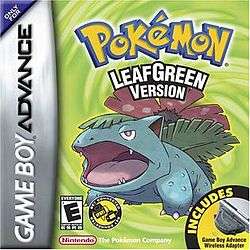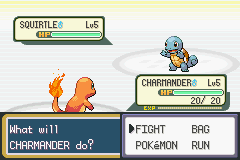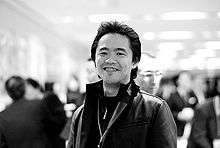''Pokémon FireRed'' and ''LeafGreen''
| Pokémon FireRed Pokémon LeafGreen | |
|---|---|
 | |
| Developer(s) | Game Freak |
| Publisher(s) | The Pokémon Company |
| Director(s) | Junichi Masuda |
| Producer(s) |
Hiroyuki Jinnai Takehiro Izushi Hiroaki Tsuru |
| Artist(s) | Ken Sugimori |
| Writer(s) |
Hitomi Sato Satoshi Tajiri |
| Composer(s) |
Go Ichinose Junichi Masuda |
| Series | Pokémon |
| Platform(s) | Game Boy Advance |
| Release | |
| Genre(s) | Role-playing video game |
| Mode(s) | Single-player, multiplayer |
Pokémon FireRed Version and LeafGreen Version[lower-alpha 1] are enhanced remakes of the original Pokémon Red and Blue video games, which were released in 1996. The new titles were developed by Game Freak and published by Nintendo for the Game Boy Advance and have compatibility with the Game Boy Advance Wireless Adapter, which originally came bundled with the games. FireRed and LeafGreen were first released in Japan in January 2004 and released in North America and Europe in September and October respectively. Nearly two years after their original release, Nintendo re-marketed them as Player's Choice titles. The two games hold the distinction of being the first enhanced remakes of previous games within the franchise.
FireRed and LeafGreen are members of the Pokémon series of role-playing video games. As in previous games, the player controls the player character from an overhead perspective and participates in turn-based combat encounters. However, new features such as a contextual help menu and a new region the player may access have also been added. Throughout the games, the player captures and raises Pokémon for use in battle.
The games received mostly positive reviews, obtaining an aggregate score of 81 percent on Metacritic. Most critics praised the fact that the games introduced new features while still maintaining the traditional gameplay of the series. Reception of the graphics and audio was more mixed, with some reviewers complaining that they were too simplistic and lacked improvement compared to the previous games, Pokémon Ruby and Sapphire. FireRed and LeafGreen were commercial successes, selling a total of around 12 million copies worldwide.
Gameplay

As with all Pokémon role-playing games released for handheld consoles, FireRed and LeafGreen are in third-person, overhead perspective. The main screen is an overworld, in which the player navigates the protagonist.[2] Here a menu interface may be accessed, in which the player may configure his or her Pokémon, items, and gameplay settings.[3] When the player encounters a wild Pokémon or is challenged by a trainer, the screen switches to a turn-based battle screen that displays the player's Pokémon and the engaged Pokémon. During a battle, the player may select a move for his or her Pokémon to perform, use an item, switch his or her active Pokémon, or attempt to flee. All Pokémon have hit points (HP); when a Pokémon's HP is reduced to zero, it faints and can no longer battle until it is revived. Once an enemy Pokémon faints, all of the player's Pokémon involved in the battle receive a certain amount of experience points (EXP). After accumulating enough EXP, a Pokémon may level up.[4]
Capturing Pokémon is another essential element of the gameplay. During a battle with a wild Pokémon, the player may throw a Poké Ball at it. If the Pokémon is successfully caught, it will come under the ownership of the player. Factors in the success rate of capture include the HP of the target Pokémon and the type of Poké Ball used: the lower the target's HP and the stronger the Poké Ball, the higher the success rate of capture.[5]
While FireRed and LeafGreen are remakes of Red and Green (Pokémon Green was only released in Japan, whereas the American version was Blue), they contain usability enhancements such as a contextual tutorial feature which allows players to look up data at any point in the game. Additionally, when continuing a saved game, players are shown the last four actions they performed, allowing them to remember what they were doing.[6]
The games support the Game Boy Advance Game Link Cable, through which connected players may trade or battle.[7] Players may also connect with Pokémon Ruby and Sapphire, as well as with Pokémon Colosseum, allowing them to obtain over 350 Pokémon.[8] FireRed and LeafGreen also have the ability to connect to the Nintendo GameCube and interact with Pokémon Box: Ruby and Sapphire. In Box, the player may organize and view his or her collected Pokémon, and in Colosseum, Pokémon may be used in battle.[9] FireRed and LeafGreen are also the first games in the series to be compatible with the Game Boy Advance Wireless Adapter, which comes prepackaged with the games.[8] The adapter can be plugged into the link port of the Game Boy Advance system and allows players within a radius of 30–50 feet (9–15 meters) to wirelessly interact with each other.[6] In addition, as many as 30 players at a time may join a special location called the "Union Room", where they can trade, battle, or chat.[8] Nintendo has set up "JoySpots" at Japanese retail locations for this purpose.[6]
Plot
Setting
Pokémon FireRed and LeafGreen takes place mostly in the fictional region of Kanto. This is one distinct region of many in the Pokémon world, which includes varied geographical habitats for the Pokémon species, human-populated towns and cities, and routes between locations. Some areas are only accessible once the player acquires a special item or one of the player's Pokémon learns a special ability.[10] Near the end of the plot, the protagonist is able to venture to the Sevii Islands, a new area not present in the original Red and Blue games. The Sevii Islands are an archipelago of seven islands and contain Pokémon normally exclusive to the Johto region, as well as several post-game missions. After the aforementioned missions on the Sevii Islands are completed, trading with Pokémon of the Hoenn region becomes available.
Synopsis
The silent protagonist of FireRed and LeafGreen is a child who lives in a small town named Pallet Town. After players start a journey and venture alone into tall grass, a voice warns them to stop. Professor Oak, a famous Pokémon researcher, explains to the player that such grass is often the habitat of wild Pokémon, and encountering them alone can be very dangerous. He takes the player to his laboratory where the player meets Oak's grandson, another aspiring Pokémon Trainer. The player and their rival are both instructed to select a starter Pokémon for their travels. The rival then challenges the player to a Pokémon battle with their newly obtained Pokémon and continues to battle the player at certain points throughout the games.
After reaching the next city, the player is asked to deliver a parcel to Professor Oak. Upon returning to the laboratory, the player is presented with a Pokédex, a high-tech encyclopedia that records the entries of any Pokémon that are captured.[11] Oak asks the player to fulfill his dream of compiling a comprehensive list of every Pokémon in the game.
While visiting the region's cities, the player encounters special establishments called Gyms. Inside these buildings are Gym Leaders, each of whom the player must defeat in a Pokémon battle to obtain a Gym Badge.[12] Once a total of eight badges are acquired, the player is given permission to enter the Pokémon League, which consists of the best Pokémon trainers in the region. There the player battles the Elite Four. Also throughout the game, the player has to fight against the forces of Team Rocket, a criminal organization that abuses Pokémon. They devise numerous plans to steal rare Pokémon, all of which the player must foil, meeting and defeating the organization boss Giovanni.
After the first time the player defeats the Elite Four, one of the members, Lorelei, disappears. After gaining access to the Sevii Islands, an entirely new region, the player discovers Lorelei in her house and convinces her to come back with him. Once more, the protagonist must thwart the Team Rocket's plans on several occasions, recover two artifacts, the Ruby and the Sapphire, and put them in the main computer at One Island. After that, the player can communicate, battle, trade, etc., with Ruby and Sapphire.
Development

FireRed and LeafGreen were first announced in September 2003 as upcoming remakes of the original Pocket Monsters Red and Green games that were released in Japan in 1996.[13] Game director Junichi Masuda stated the new titles would be developed around the idea of simplicity,[14] as the game engine was a slightly modified version of the one used in Pokémon Ruby and Sapphire. As a result, FireRed and LeafGreen were made fully backward compatible with Ruby and Sapphire, allowing players to trade Pokémon between games.[15]
FireRed and LeafGreen's connectivity with the Game Boy Advance Wireless Adapter was heralded by Nintendo president Satoru Iwata as being able "to enhance head-to-head battles, exchange of information, and communication with others."[16] An enhanced interface was created for the game to increase usability for new players, as well as a contextual in-game help system that could aid lost or confused players during their journey. President of The Pokémon Company Tsunekazu Ishiharu noted, "We don't feel that this a remake at all. We feel that this is a new game, with wireless technology", referring to the bundled wireless adapter.[17]
The music used in the titles was derived from the classic game consoles, and arranged by Go Ichinose. Masuda and Ichinose decided not to change the reused music from the basic background sounds used in the originals, and instead updated them by adding additional sounds. Some of the songs have additional key changes compared to the original soundtrack and some songs that are re-written for the GBA contain sliding between notes.[18] A two-disc set of the music entitled GBA Pokémon FireRed & LeafGreen Super Complete was released, with the first disc featuring all the music used normally in-game, while the second disc featured bonus tracks based on and inspired by the music in the games. Among these are two vocal tracks.[19]
Track list of GBA Pokémon FireRed & LeafGreen Super Complete:
| DISC 1 | ||||||||||||||||||||||||||||||||||||||||||||||||||||||||||||||||||||||||||||||||||||||||||||||||||||||||||||||||||||||||||||||||||||||||||||||||||||||||||||||||||||||||||||||||||||||||||||||||||||||||||||||||||||||||||||||||||||||||||||||||||||||||||||||||||||||||||||||||||||||||||||||||||||||||||||||||||||||||||||||||||||||||||||||||||||||||||||||||||||||||||||||||||||||||
|---|---|---|---|---|---|---|---|---|---|---|---|---|---|---|---|---|---|---|---|---|---|---|---|---|---|---|---|---|---|---|---|---|---|---|---|---|---|---|---|---|---|---|---|---|---|---|---|---|---|---|---|---|---|---|---|---|---|---|---|---|---|---|---|---|---|---|---|---|---|---|---|---|---|---|---|---|---|---|---|---|---|---|---|---|---|---|---|---|---|---|---|---|---|---|---|---|---|---|---|---|---|---|---|---|---|---|---|---|---|---|---|---|---|---|---|---|---|---|---|---|---|---|---|---|---|---|---|---|---|---|---|---|---|---|---|---|---|---|---|---|---|---|---|---|---|---|---|---|---|---|---|---|---|---|---|---|---|---|---|---|---|---|---|---|---|---|---|---|---|---|---|---|---|---|---|---|---|---|---|---|---|---|---|---|---|---|---|---|---|---|---|---|---|---|---|---|---|---|---|---|---|---|---|---|---|---|---|---|---|---|---|---|---|---|---|---|---|---|---|---|---|---|---|---|---|---|---|---|---|---|---|---|---|---|---|---|---|---|---|---|---|---|---|---|---|---|---|---|---|---|---|---|---|---|---|---|---|---|---|---|---|---|---|---|---|---|---|---|---|---|---|---|---|---|---|---|---|---|---|---|---|---|---|---|---|---|---|---|---|---|---|---|---|---|---|---|---|---|---|---|---|---|---|---|---|---|---|---|---|---|---|---|---|---|---|---|---|---|---|---|---|---|---|---|---|---|---|---|---|---|---|---|---|---|---|---|---|---|---|---|---|---|---|---|---|---|---|---|---|---|---|---|---|---|---|---|---|---|---|---|---|---|---|---|---|---|---|---|---|---|---|---|---|---|---|---|
| ||||||||||||||||||||||||||||||||||||||||||||||||||||||||||||||||||||||||||||||||||||||||||||||||||||||||||||||||||||||||||||||||||||||||||||||||||||||||||||||||||||||||||||||||||||||||||||||||||||||||||||||||||||||||||||||||||||||||||||||||||||||||||||||||||||||||||||||||||||||||||||||||||||||||||||||||||||||||||||||||||||||||||||||||||||||||||||||||||||||||||||||||||||||||
| DISC 2 | ||||||||||||||||||||||||||||||||||||||||||||||||||||||||||||||||||||||||||||||||||||||||||||||||
|---|---|---|---|---|---|---|---|---|---|---|---|---|---|---|---|---|---|---|---|---|---|---|---|---|---|---|---|---|---|---|---|---|---|---|---|---|---|---|---|---|---|---|---|---|---|---|---|---|---|---|---|---|---|---|---|---|---|---|---|---|---|---|---|---|---|---|---|---|---|---|---|---|---|---|---|---|---|---|---|---|---|---|---|---|---|---|---|---|---|---|---|---|---|---|---|---|
| ||||||||||||||||||||||||||||||||||||||||||||||||||||||||||||||||||||||||||||||||||||||||||||||||
The exclusive Japanese production run for FireRed and LeafGreen was limited to half a million copies, despite the success of Pokémon Ruby and Sapphire. IGN speculated that Nintendo was expecting less demand for the new games, or that it was limited by the production of the bundled wireless adapter.[20] The east American versions of FireRed and LeafGreen were secondly indirectly announced at DICE in 2004.[21] Although the original games were released as Red and Blue in North America, the remakes retained the Japanese names of "Red" and "Green".[22] Masuda noted this as a choice on his part, stating the leaf represented a peaceful icon, in contrast to the alternative of water which he saw as suggesting conflict with the icon of fire used by the other game.[14]
Reception
| Reception | ||||||||||||||||||||||||
|---|---|---|---|---|---|---|---|---|---|---|---|---|---|---|---|---|---|---|---|---|---|---|---|---|
| ||||||||||||||||||||||||
During its first week of release in Japan, FireRed and LeafGreen sold a combined total of 885,039 copies, which was less than the amount sold by Pokémon Ruby and Sapphire in that time period, but IGN reasoned that the smaller sales were due to the new titles being remakes.[30] In the first half of August before FireRed and LeafGreen were released in the U.S., the games received over 150,000 pre-orders, over twice the amount that Ruby and Sapphire received. Nintendo's Senior Vice President of Marketing and Corporate Communication George Harrison remarked, "This pre-sell indicates more than twice the player interest!"[31] Over one million copies of FireRed and LeafGreen were sold in the US less than one month after their release in that region.[32] As of March 31, 2008, the games had sold 11.82 million copies worldwide.[33] The games later entered Nintendo's Player's Choice line in North America and were re-marketed with a significantly lower retail price. However, unlike the original release, the Player's Choice edition games did not include a bundled Wireless Adapter.[34]
Reviews of FireRed and LeafGreen were mostly positive, and the games currently hold an aggregate score of 81 percent on Metacritic.[24] Craig Harris of IGN gave the games an "Outstanding" 9.0/10 rating and praised the creators of the games for creating a game that "works extremely well for the handheld market. It doesn't have quite the same variety as Ruby/Sapphire, but it's still incredibly satisfying." Harris was less positive about the games' graphics, which he thought were "limited" and "basic".[8] GameSpot's Greg Kasavin, who gave the games 8.4 out of 10, commented that "though Pokémon could probably use a few new twists after all these years, FireRed and LeafGreen are great role-playing games on their own merits, filled with lots more content and more challenges than last year's Ruby and Sapphire, and offering up plenty of addictive gameplay that can be a lot of fun for players of all ages." Unlike Harris, Kasavin praised the games' graphics for their "colorful good looks and the endearing character designs that the series is known for."[27] Game Informer rated the games a "Very Good" 8/10 for being "a lot of fun", yet they saw the graphics as "utterly unremarkable" when compared to other handheld games.[26]
GameSpy reviewer Phil Theobald, who awarded the games four out of five stars, stated, "Before I knew it, I was hooked all over again. The engrossingly simple gameplay combined with the more-strategic-than-they-first-appear battles was just too much to resist. And yeah, the 'gotta catch 'em all' gimmick is still effective, not to mention necessary to build a well balanced party. There's just something about tracking down, capturing, and training all those Pokémon that really draw you into the game's world." He justified the games' graphics by comparing them to the "ugly" original Red and Blue versions. Additional praise was given to the new features such as the contextual tutorial, and flashbacks when loading a saved game, as well as the games' multiplayer capabilities via the Wireless adapter.[28]
Notes
- ↑ Pokémon FireRed Version and LeafGreen Version (ポケットモンスターファイアレッド・リーフグリーン Poketto Monsutā Faiareddo & Rīfugurīn, lit. "Pocket Monsters: FireRed & LeafGreen")
References
- 1 2 3 "Pokemon FireRed Version for Game Boy". GameSpot. Retrieved 2009-06-22.
- ↑ Game Freak (2004). Pokémon FireRed and LeafGreen Instruction Booklet. Nintendo. p. 14.
- ↑ Game Freak (2004). Pokémon FireRed and LeafGreen Instruction Booklet. Nintendo. p. 16.
- ↑ Game Freak (2004). Pokémon FireRed and LeafGreen Instruction Booklet. Nintendo. pp. 24–28.
- ↑ Game Freak (2004). Pokémon FireRed and LeafGreen Instruction Booklet. Nintendo. p. 31.
- 1 2 3 IGN Staff (2004-05-11). "Pokemon FireRed Version Preview". IGN. Retrieved 2008-12-24.
- ↑ Game Freak (2004). Pokémon FireRed and LeafGreen Instruction Booklet. Nintendo. pp. 58–59.
- 1 2 3 4 5 Harris, Craig (2004-09-03). "Pokemon FireRed Version Review". IGN. Retrieved 2008-12-24.
- ↑ Game Freak (2004). Pokémon FireRed and LeafGreen Instruction Booklet. Nintendo. pp. 62–63.
- ↑ Game Freak (2004). Pokémon FireRed and LeafGreen Instruction Booklet. Nintendo. p. 41.
- ↑ Game Freak (2004). Pokémon FireRed and LeafGreen Instruction Booklet. Nintendo. p. 8.
- ↑ Game Freak (2004). Pokémon FireRed and LeafGreen Instruction Booklet. Nintendo. pp. 46–47.
- ↑ GameSpot Staff (2003-09-15). "Pokémon remakes on the way". GameSpot. Archived from the original on 2011-04-05. Retrieved 2009-06-17.
- 1 2 Masuda, Junichi (2004-08-30). "Hidden Power of Masuda". Game Freak. Archived from the original on 2009-06-22. Retrieved 2009-06-22.
- ↑ Harris, Craig (2003-09-12). "More Pokemon for GBA". IGN. Retrieved 2009-09-15.
- ↑ Calvert, Justin (2003-09-26). "TGS 2003: Wireless GBA multiplayer for 2004". GameSpot. Archived from the original on 2011-04-05. Retrieved 2009-06-17.
- ↑ Harris, Craig (2004-05-13). "E3 2004: The Pokémon Creators Speak". IGN. Retrieved 2009-06-17.
- ↑ Masuda, Junichi (2008-02-28). "Hidden Power of Masuda". Game Freak. Archived from the original on 2009-06-22. Retrieved 2009-06-22.
- ↑ Rubinshteyn, Dennis. "GBA Pokémon Firered & Leafgreen Music Super Complete". RPGFan. Retrieved 2009-06-22.
- ↑ IGN Staff (2004-01-16). "Nintendo holds back on Pokémon". IGN. Retrieved 2009-06-17.
- ↑ Harris, Craig (2004-03-04). "Pokémon Red/Green US bound". IGN. Retrieved 2009-06-17.
- ↑ IGN Staff (2004-05-11). "E3 2004: Pokémon Fire Red". IGN. Retrieved 2009-06-17.
- ↑ "Pokemon FireRed Version for GameBoy Advance". GameRankings. Retrieved 2009-06-23.
- 1 2 "Pokemon FireRed (gba: 2004): Reviews". Metacritic. Archived from the original on 2008-06-18. Retrieved 2009-06-23.
- ↑ Deci, T.J. "Pokémon: FireRed Version - Overview". Allgame. Retrieved 2009-07-25.
- 1 2 Juba, Joe (October 2004). "Pokémon FireRed/LeafGreen review". Game Informer (138): 146. Archived from the original on May 28, 2007.
- 1 2 Kasavin, Greg (September 7, 2004). "Pokemon FireRed Version Review". GameSpot. Archived from the original on 2011-04-05. Retrieved 2009-06-23.
- 1 2 Theobald, Phil (2004-09-07). "GameSpy: Pokémon FireRed". GameSpy. Retrieved 2009-06-23.
- ↑ Nintendo Power staff (October 2004). "Pokémon FireRed and Pokémon LeafGreen review". Nintendo Power (184): 123.
- ↑ IGN Staff (2004-02-02). "Pokemania". IGN. Retrieved 2009-09-15.
- ↑ Pringle, James B. (2004-08-20). "Pokemon Games Receive Huge Pre-Order Numbers". IGN. Retrieved 2009-09-15.
- ↑ Harris, Craig (2004-10-05). "GBA Game of the Month: September 2004". IGN. Retrieved 2009-09-15.
- ↑ "Financial Results Briefing for Fiscal Year Ended March 2008" (PDF). Nintendo. 2008-04-25. p. 6. Retrieved 2008-04-25.
- ↑ Harris, Craig (2006-07-26). "IGN: Player's Choice, Round Two". IGN. Retrieved 2009-06-23.
External links
- Official website (archived 2010-01-17)
- Pokémon FireRed and LeafGreen Versions on Bulbapedia
0.0